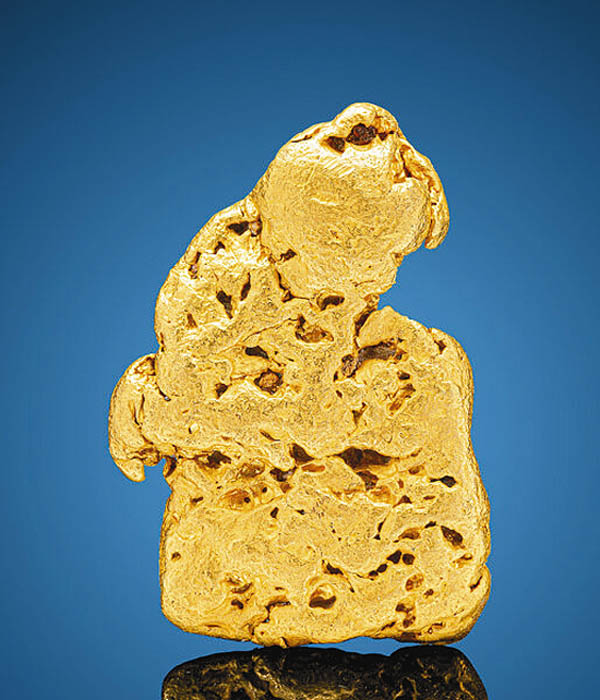Spectacular Pieces Of Mars And The Moon Among Natural History Wonders In Auction
Rare Fossils And Minerals Included In Nature And Science Sale
January 01, 1970
How much would you pay for a piece of Mars? A piece of our Moon? The skeleton of a cat that roamed the planet 20 million years ago? How do we measure the value of mind-boggling time and distance? And how profane is the question of price when we attempt to value the seemingly invaluable? Again and again, humans wrestle with the inevitability of gathering and, ultimately, evaluating and distributing the true marvels of our Earth and cosmos. Its not a job for the faint of heart. Collectors, scientists, students and institutions continue to invest time and energy in these objects because they give us a clearer picture of who were are, where we came from, and where were headed. We have been working for months to put together a stunning assortment of rare, unusual, and, of course, highly collectible specimens from a number of natural history and scientific categories, says Craig Kissick, Heritages director of nature and science, who also happens to be the president of the Association of Applied Paleontological Sciences. On Friday, Nov. 4, Heritage will present its final Nature and Science Signature Auction for 2022, and Kissick and watchful collectors alike are invested in this showcase of superlative meteorites, including exceptional lunar and Martian examples, as well as an amazing group of fossil varieties accompanied by collector-grade fine minerals, historical scientific items and even an elephant bird egg! Kissicks knowledge runs deep and wide, and at Heritage he grapples with the very profundity of the universe. How can you not when someone places a piece of Mars in your hand? About that Mars rock. This uniquely large piece of the Red Planet is actually black and shot through with green due to large grains of olivine that are a type of peridot. NWA 12269 was classified in accordance with renowned scientist Dr. Anthony Irving of the University of Washington and others as a Martian meteorite of the rare shergottite variety. It was discovered in 2018 in Northwest Africa with a total known weight of 1,679 grams, and this superb example weighing 1,672 grams is the main mass of NWA 12269. Warp-driving back this way to the Moon. Heritage is offering extraordinary specimens from our only natural satellite. Topping the category is the lunar meteorite known as NWA 13119, which was found in Mauritania in 2019 and classified by the standards of legendary scientist Dr. Carl B. Agee, director of the Institute of Meteoritics at the University of New Mexico. Nearly 10 inches long and weighing 7.9 pounds, this colossal specimen exhibits a phenomenal planetary texture over its entirety and is captivating from every side and angle, stated Kissick. The classic feldspathic breccia features numerous lighter-colored clasts within a dark body color. This singular specimen, if for no other reason than the immense size, is truly incredible. This museum-quality specimen places it in the upper echelon of any lunar meteorite variety. There are other rare specimens from Mars and the Moon in this auction of the quality collectors long for, and yet they make up only a fraction of the wonders on offer. Earth itself has 4.5 billion years under its belt and extends its own timeless treasures. For example: an intriguing and unusual full skeleton of a Pogonodon measuring five feet long. This rare primitive carnivore is known as a nimravid, a saber-toothed cat of sorts comparable to modern-day leopards and lions. Its endemic to North America and went extinct during the Miocene Epoch. This specimen was discovered in South Dakota. Another Earthly treasure is a massive gold nugget from Australia. Less than two percent of all gold exists in a nugget form; the majority of the precious metal is melted down. Larger nuggets, such as this serious example, weighing 21.8 troy ounces, are really few and far between, says Kissick. Gold from Australia boasts a high purity content, and this specimen exhibits very little associated Quartz matrix. With complex texture and two sides that could be the primary display face, this is a highly collectible as well as significantly valuable specimen of the universally iconic mineral. There are more than 200 exceptional specimens from space and Earth in this auction, including the aforementioned elephant bird egg. This collectible egg from Madagascar stands over 11 inches (28 centimeters) tall. Aepyornis, extinct by the 17th century, was one of the heaviest and largest birds in the world, reaching over 10 feet and weighing nearly 900 pounds. The bird was a prime example of the phenomenon of island gigantism, of which this egg is certainly a testament. A treasure from the ever-popular Jurassic Period, the Ichthyosaur fossil is a marine reptile that lived in prehistoric oceans when the dinosaurs roamed the land. This specimen of Stenopterygius came out of the acclaimed Posidonienschiefer Shale Formation from the famous Holzmaden Lagersttte of Bavaria, Germany. This fish lizard, as its name translates, represents an outstanding opportunity. With significant size and exquisite detail of its skull, teeth, vertebrae, ribs, and flippers, this is one supremely collectible version of an uncommon variety of aquatic creature, said Kissick. The black shale matrix that houses it provides an excellent background for bony material and other remnants. Its overall dimensions make it ideal for a wall-hanging display. This auction, in other words, contains the history of our universe. It includes a mind-bending array of our natural history, including a cave bear skeleton, a wooly mammoth tusk, a spectacular Virgin Valley opal, and a fossilized bat that retains so much detail it makes your head spin. This is an opportunity to explore the very matter that makes us who we are and takes us to a realm so meaningful and profound that we can only begin to understand its true value. Images and information about all lots in the auction can be found at www.HA.com/8099.



SHARE
PRINT